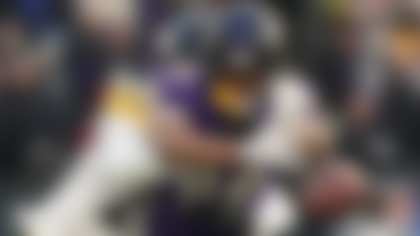Rich McKay has been involved in the NFL since he was a ballboy in Tampa Bay when his late father John McKay was coach of the Buccaneers. Rich has grown up to be one of the NFL's most influential leaders, serving as the general manager of the Bucs for 10 years and then working the last 10 years as the president of the Atlanta Falcons. He also was the Falcons' general manager for the first five years of his tenure in Atlanta.
McKay, 54, is a member of the highly respected NFL Competition Committee, which helps to set the league's agenda as it relates to playing rules. Not long after being appointed to the group in 1995, he was promoted to chairman.
The Princeton graduate talked with NFL Evolution contributing editor Bill Bradley on Friday about his role with the Competition Committee, how this season's new player safety rules played out and what's next for the committee during the offseason.
How did you get involved with the Competition Committee?
I was appointed to the committee by Commissioner [Paul] Tagliabue in 1995. I'm not sure how, but I was pleasantly surprised to do so.
That's been almost 20 years on the committee.
"It is. That's a good long time on the committee. I think the most impressive thing for me about it all was the initial experience, which was somewhat overwhelming. That's because of who was on it: Don Shula and George Young were the co-chairs; you had Marty Schottenheimer on the committee; you had a lot of people with a lot of football knowledge on that Committee.
How much does the Competition Committee interact during the season?
Not very much. Unless something comes up that we're going to talk about that may be necessary early in the offseason, like something related to the [NFL Scouting] Combine or something related to personnel rules immediately in the offseason. Then there may be a call scheduled. This year we had one or two of those calls. We don't get involved in any interpretations or rules that are being looked at during the season, if any need to be. Just because people [on the committee] work for teams, it just never felt appropriate that the committee would get involved on in-season work.
How does the committee interact with its subcommittees, such as the coaches subcommittee run by John Madden? Does that work happen during the season?
They have calls during the season and I talk to Coach Madden myself just to go through what he is thinking about and what we might be thinking about in the upcoming offseason. Then we get together in Indianapolis (prior to the NFL Combine). The Coaches Subcommittee gets together with the Competition Committee and we go through some things they're working on. He does a good job of soliciting ideas to make sure that when we're forming the offseason agenda, we're forming it with a lot of the ideas and issues that they've been talking about. They're good on connectivity and coach Madden does a really good job of that.
We've heard John Madden has had a wide range of ideas every year on how to change the game, including some very radical suggestions at times. How often does he bring those to the committee?
All the time. He likes to bring them up and he's OK with the idea that when fully vetted that we don't adopt them. It doesn't mean he's not going to bring them up at a different time. But he is definitely somebody that I am happy to have involved in the National Football League, and the NFL is lucky to have John Madden.
How does the committee track new rules -- such as the player-safety rules passed last March -- and how they are working once the season begins?
You really track in the offseason. It's not like I get something from the league office that says how many times this new player safety rule has been called or how many times it has caused a fine. Now when we get to the offseason, we will get that information. We will go back and look at the tape. We will go back and talk to the officials because we'll actually have officials come to the meeting in Indianapolis and give us feedback on how the rules are working. Our feelings on enforcement of new rules is that it takes two years for the rule to be firmly in place and everybody is going to have a very clear understanding of how it was going to operate. We try not to flyspeck the examination of a new rule in Year 1, but it is good to see how rules are enforced.
The most controversial rule addition during the offseason was the "crown-of-the-helmet" rule. How do you think that rule has played out through the season?
We were happy with the rule, I think. We want to see it in the offseason with respect to tape. But I think the No. 1 thing that we've all heard and seen is that it's become a point of emphasis for coaches as a teaching point. That is what the design of the rule was. We hoped that the rule would push its way all the way down to Pop Warner Football and it would become a point of emphasis that you do not play with the crown of your helmet. I think that is going to take hold. That will take some time, but what we like is the feedback from coaches that it became a point of emphasis for them. The more years we have with that rule behind us, the better players will be able to conform themselves to the rule.
How long will it take for that rule to bubble up from the youth level?
It will take some years. I think what drove a little bit of the rule passage for us was that when you watched tape of high school football and of college football, you saw players that were much more willing to play with the top of their helmet in the open field. That was concerning to us. It will take a little while. First of all, you've got to see if high schools will adopt such a rule and then you've got to see it just get pushed down. It is not something that's going to happen in the first year or two. It's going to take some years. On our level, it can happen quicker because players will see flags and/or fines. So we might be able to get these actions to conform quicker than it might at the lower levels.
How has it helped that the NCAA added an ejection element to its "targeting" rule during the same year the NFL instituted the "crown-of-the-helmet" rule?
I think it shows a point of emphasis on what (NFL) Commissioner (Roger) Goodell said last year at the Super Bowl -- that as the game progresses, we have to find ways to take the helmet out of the football. I think the combination of our rule passage last year and by the colleges continues to emphasize that point.
The crown of the helmet hasn't been called very often, but it has been closely monitored by the league. Did you expect the officials to call it more often?
We said this was not going to be an easy rule for officials to officiate at full speed. Like the players, they're going to have to get accustomed to seeing it, and they don't get practice time to do this because we don't tackle in the offseason until training camp. It's going to be a hard rule to get comfortable with and (for the referees) to see it. I have to see the tape to see how it worked, but we were more concerned with the teaching of the rule and potentially the fining with the rule. Then, as they get more comfortable, the calling of the rule as far as the number of fouls called.
When the committee passed more rules protecting the head, did the members anticipate some of the rhetoric from players about targeting players' knees?
We've heard it before. I've been on the committee a long, long time now. I think in (1995) and '96 we put a lot more teeth into the defenseless receiver rules. That's been 18 years ago. I remember the discussions at that point in time were, "Well, if you're not going to allow us to hit, then you're going to get a lot of knee injuries and a lot of lower leg injuries because we're going to go low." Our intention all along is that you've got a targeted area that is from the mid-chest area to the thigh area. There's plenty of space in there. There are instances where receivers get themselves in positions that definitely taxes the defensive back as to where to strike them. But we are not seeing the backend people go low and that has led to lower leg injuries. This year, there's no question there were a couple of very obvious plays where players were hurt by low hits -- and we'll go back and look at those in the offseason. But again, I don't think the numbers are such that it's been what players may have said it was going to be.
During the season, the most talked about new player-safety rule has been, oddly enough, the "push rule" and the "line-overload rule" on place kicks. Did you think this rule change would take on some controversy?
No, not really. It's an interesting one and you brought up coach Madden's subcommittee. That suggestion came from coach Madden's subcommittee with tape. I think [New York Giants coach Tom] Coughlin brought us tape that showed us what was going on in respect to kick plays. They wanted the rule at the line modified. I think the players that participated in the meeting in Indianapolis absolutely endorsed that change. I don't think we expected it to get [the publicity], but it reinforces the idea that it takes a little while for people to get a full and clear understanding of the rule. Every once in a while, they caught themselves in the wrong position and a flag was thrown. Or, in some instances, a still picture was taken that showed officials should have thrown a flag.
How do you think the rule against the peel-back block been received by offenses and defenses?
Good. I think people have understood that if we're going to go back and block toward our goal line, then we're not going to go high and we're not going to go low. What's happening is that the player is pursuing the runner and just cannot anticipate the block, so our feeling is that you've got to give that player added protection because they just don't see it coming. I think players are pretty comfortable with that rule.
This season we have heard players want the low block -- or the cut block -- outlawed, especially after a few players have been injured from it this season. Is the committee considering that option?
I don't know about that. I think last year and years past we brought defensive linemen (into the Competition Committee meetings). We brought offensive line coaches and defensive line coaches. We've gone through cut blocks and the chop block. There's always been that statement from defensive linemen that "I can anticipate a low block and I can play a low block. And I don't mind playing a low block, because once the low block is over, if I use my hand appropriately, I can be a free defensive player." But that doesn't mean you wouldn't go back and talk about the chop block, which is a high-low combination. I think that's one that every year for the last seven or eight years that we have looked at, talked about, and I'm sure we will again this year.
What's on the radar for the Competition Committee? Are there any player-safety rules issues on the committee's agenda for next season?
The agenda will be set in the pretty near future. We'll send out a survey to all of the 32 clubs. We'll get feedback from owner level, the president level, the GM level and the coach level. That usually creates a lot of issues to be talked about. We'll get some from the Coaches Subcommittee. We'll get some from the players, and player safety issues will come from that. But I wouldn't say that there's one just sitting in the forefront waiting to be talked about.



